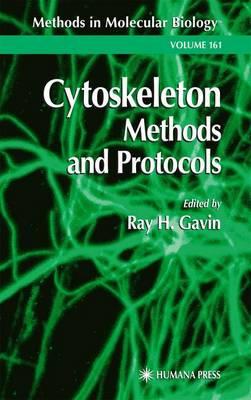Overview
Ray H. Gavin brings together an international panel of experienced researchers to detail the readily reproducible methods that utilize biochemistry, immunology, genetics, microscopy, and image analysis for investigating cytoskeleton structure and function. Each protocol contains proven step-by-step instructions that enable both the novice and the experienced researcher to achieve successful experimental results. The protocols utilize diverse model systems in a variety of organisms, including Saccharomyces, Micrasterias, Tetrahymena, Drosophila, Spisula, and Xenopus. Microscopy applications include digital-video microscopy and computer-assisted systems for the evaluation of cell motility and morphology. State-of-the-art and highly practical, Cytoskeleton Methods and Protocols makes available a diverse collection of powerful experimental systems and tools for successfully studying cytoskeleton structure and function.
Full Product Details
Author: Ray H. Gavin
Publisher: Humana Press Inc.
Imprint: Humana Press Inc.
Edition: 2001 ed.
Volume: 161
Weight: 0.437kg
ISBN: 9781617371813
ISBN 10: 1617371815
Pages: 302
Publication Date: 10 November 2010
Audience:
College/higher education
,
Professional and scholarly
,
Undergraduate
,
Professional & Vocational
Format: Paperback
Publisher's Status: Out of Print
Availability: Out of stock 
Table of Contents
Part I. Identification of Cytoskeleton Proteins. Using an Inverse PCR Strategy to Clone Large, Contiguous Genomic DNA Fragments, Jorge A. Garces and Ray H. Gavin. Microsequencing of Myosins for PCR Primer Design, Elaine L. Bearer. Evaluating the Dynein Heavy Chain Gene Family in Tetrahymena,Gangadhara Sailaja, Leslie M. Lincoln, Jifan Chen, and David J. Asai. Part II. Microscopy Applications. Video-Enhanced Microscopy for Analysis of Cytoskeleton Structure and Function, George M. Langford. Computer-Assisted Systems for the Analysis of Amoeboid Cell Motility, David R. Soll, Deborah Wessels, Edward Voss, and Olof Johnson. Evaluation of Individual-Cell Motility, Peter S. Walmod, Rasmus Hartmann-Petersen, Anton Berezin, Soren Prag, Vladislav V. Kiselyov, Vladimir Berezin, and Elizabeth Bock. Evaluation of Cell Morphology, Eugene A. Lepekhin, Peter S. Walmod, Anton Berezin, Vladimir Berezin, and Elisabeth Bock. A Quantitative Assay for Measurement of Chemokinesis in Tetrahymena, Uffe Koppelhus, Per Hellung-Larsen, and Vagn Leick. Part III. Reagents for Studying Cytoskeleton Protein Function. Jasplakinolide: An Actin-Specific Reagent that Promotes Actin Polymerization, Andreas Holzinger. Site-Directed Antibodies as Tools For Investigating Structure and Function of Cytoskeleton Proteins, Walter Steffen and Julie L. Hodgkinson. Direct Labeling of Components in Protein Complexes by Immuno-Electron Microscopy, Julie L. Hodgkinson and Walter Steffen. Tat-Mediated Delivery of Antibodies into Cultured Cells, Walter Steffen. Part IV. Cytoskeleton Dynamics. Studying Cytoskeletal Dynamics in Living Cells Using Green Fluorescent Protein, Yisang Yoon, Kelly R. Pitts, and Mark A. McNiven. Use of Green Fluorescent Protein to Study Cellular Dynamics: Constructing GFP-Tagged Motor Enzymes, Hong Cao, Heather M. Thompson, Eugene W. Krueger, and Mark A. McNiven. Transient Transfections and Heterokaryons as Tools for the Analysis of Keratin IF Dynamics, Jesus M. Paramio and Jose L. Jorcano. Part V. Cellular Systems as Tools for Investigating Cytoskeleton Structure and Function. Chromatophores as Tools for the Study of Organelle Transport, Bruce R. Telzer and Leah T. Haimo. Centriole Duplication, Centrosome Maturation, and Spindle Assembly in Lysates of Spisula solidissima Oocytes, Andrew W. Suddith, Eugeni A. Vaisberg, Sergei A. Kuznetsov, Walter Steffen, Conly L. Rieder, and Robert E. Palazzo. Xenopus Egg Extracts as a Model System for Analysis of Microtubule, Actin Filament, and Intermediate Filament Interactions, Craig A. Mandato, Kari L. Weber, Anna J. Zandy, Thomas J. Keating, and William M. Bement. Detergent-Extracted Models for the Study of Cilia or Flagella, Charles B. Lindemann and Kathleen A. Schmitz. Part VI. Genetic Approaches for Studies of Cytoskeleton Protein Function. A Yeast Two-Hybrid Approach for Probing Cytoskeletal Protein Interactions, Jin-jun Meng and Wallace Ip. Manipulating Dynein Genes in Tetrahymena, David J. Asai, K. Mark DeWall, Leslie M. Lincoln, and Renotta K. Smith. Functional Analysis of Cytoskeletal Components in the Developing Visual System of Drosophila, Qi He. Index.
Reviews
The authors of the chapters are highly experienced and widely recognized as experts in their fields...The volume is one that the libraries of many universities and research institutes will want to own as a resource for their cytoskeleton researchers. - TRENDS in Cell Biology The material and procedures sections of the chapters are generally well detailed such that one with little previous experience might be able to carry out the procedure or adapt it to one's own particular system. The chapters include helpful hints on the techniques which are often not found in published articles. As a microscopist, I was impressed by the simple but elegant procedure of placing a finger print on the corner of a cover slip in order to determine the plane of focus in video-enhanced microscopy, presented by George Langford in Chapter 4. It is often just those very kinds of things that can mean the difference between success and failure, or at least help to reduce the frustration level of a first timer. - Microscopy and Microanalysis As a cell biologist, I was impressed by the chapters dealing with the study of cytoskeletal dynamics in living cells using green fluorescent protein and the study of organelle transport using chromatophores as tools you got the true impression you can do it thanks to the step-by-step protocols, you feel you cannot be wrong and I personally worked out one clear experiment. I will do on my own on mouse oocytes. I think the whole scientific community has to thank Dr. Gavin for providing us with such a helpful book. - European Journal of Histochemistry Cytoskeleton: Methods and Protocols emphasizes an integrative approach and is intended for novice and advanced researchers. It is highly recommended for libraries serving researchers interested in cytoskeleton structure and function and related areas of cell biology. - E-STREAMS
Author Information
Tab Content 6
Author Website:
Countries Available
All regions
|



